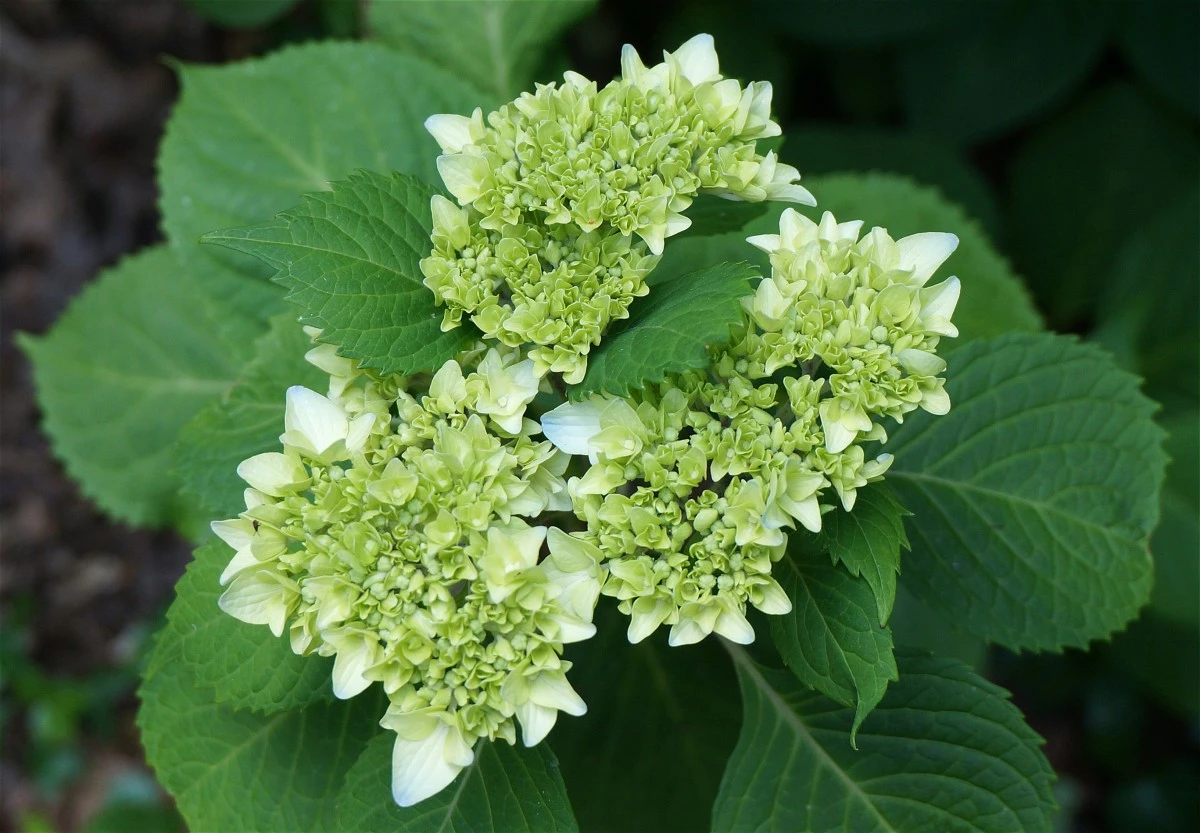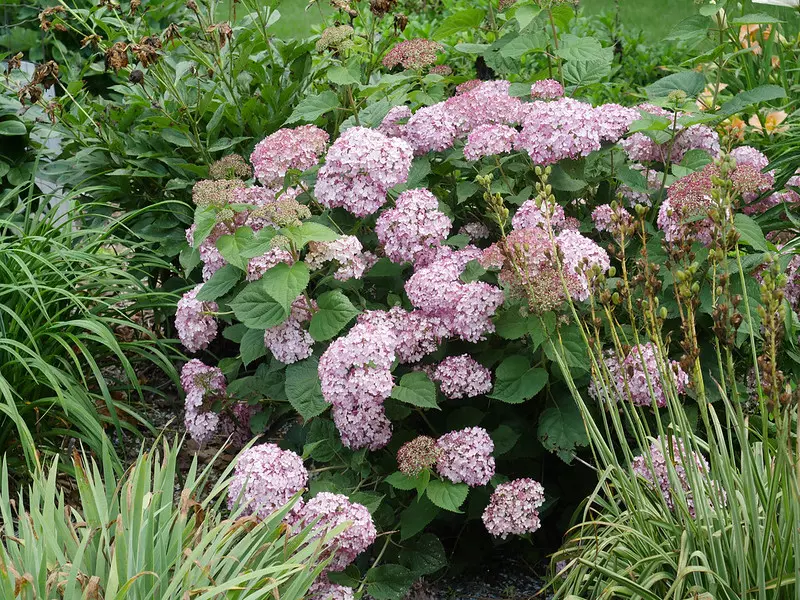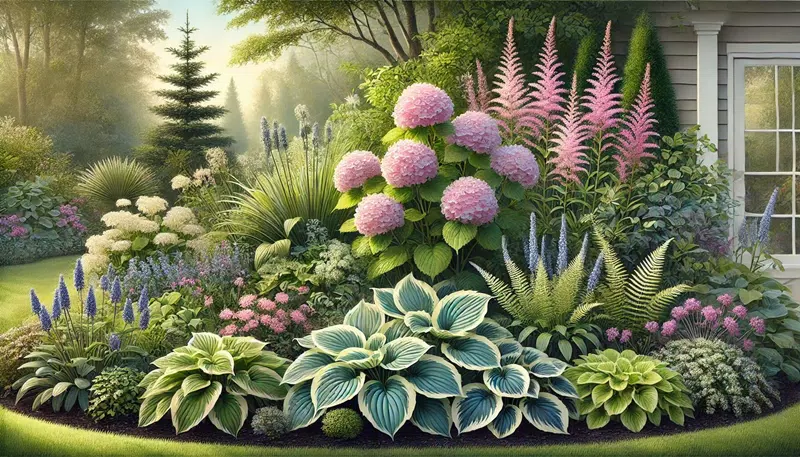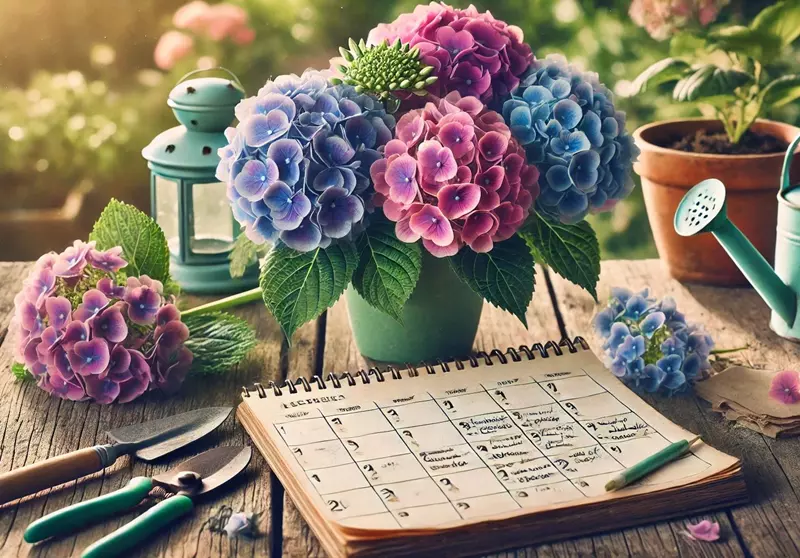
Hydrangea Companion Herbs – The Best Herbs to Grow With Hydrangeas
Learn which herbs grow best with hydrangeas. Explore expert-approved companion planting ideas to create a healthy, thriving garden bed.
Read MoreHydrangeas are cherished for their abundant blooms and lush foliage, serving as captivating focal points in gardens. To elevate their beauty and ensure a thriving garden ecosystem, it's beneficial to pair them with complementary plants. This article explores ideal companion plants for hydrangeas, offering insights into combinations that enhance aesthetic appeal and promote plant health.

Before selecting companion plants, it's crucial to understand the growing conditions that hydrangeas prefer:
Hydrangeas flourish in environments that offer a balance between sunlight and shade. They do best in moist, free-draining soil and dappled shade – not too sunny and not too shady.
These shrubs prefer moist but well-drained soil. Incorporating organic matter can enhance soil structure and fertility, promoting robust growth.
Hydrangeas require consistent moisture, especially during dry spells. Regular watering is crucial, particularly for newly planted specimens, to establish strong root systems. However, it's important to avoid waterlogged conditions, as excessive moisture can lead to root rot.
Hydrangeas are generally hardy in most parts of the UK, even in severe winters. However, late frosts can damage buds, so in colder gardens, it's advisable to grow them in a sheltered corner or against a warm wall.
Pruning requirements vary among hydrangea species. For example, for Hydrangea macrophylla, it is beneficial to prune it slightly in early spring, cutting back to the first couple of strong bud pairs to encourage fresh and vigorous growth. Conversely, Hydrangea paniculata should be pruned back hard to around 30cm above ground level each year. Understanding the specific needs of your hydrangea variety is crucial for proper pruning.
Applying a layer of mulch, such as well-rotted manure or compost, annually in spring helps retain soil moisture and regulate temperature. Hydrangeas are not particularly demanding in terms of fertilisation; minimal use of fertilisers, focusing on nitrogen, is recommended.
The flower colour of some hydrangea species, notably Hydrangea macrophylla, is influenced by soil pH. On acid soils, flowers are blue, while in alkaline soils, flowers are pink. Adjusting soil pH can alter bloom colours, but this process requires careful management and is more easily achieved in pots.
By adhering to these guidelines, gardeners can create an environment where hydrangeas thrive, resulting in a stunning display of blooms and healthy foliage.
Hostas are shade-loving perennials known for their broad, textured leaves, which provide a striking contrast to hydrangea blooms. Thriving in partial to full shade, hostas prefer moist, well-drained, slightly acidic soils—conditions that align perfectly with those favoured by hydrangeas. Their lush foliage also helps suppress weeds, contributing to garden health.

Astilbes feature feathery plumes of flowers in shades of pink, white, and red, adding vertical interest to garden beds. They thrive in partial shade and moist, well-drained soils, making them excellent companions for hydrangeas. Their delicate blooms contrast beautifully with the bold hydrangea flowers, creating a dynamic visual effect.
Ferns offer delicate, airy foliage that complements the dense blooms of hydrangeas. Preferring shady conditions and moist, well-drained soils, ferns such as the Japanese painted fern (Athyrium niponicum) or the lady fern (Athyrium filix-femina) can create a woodland garden feel when planted alongside hydrangeas.
Commonly known as coral bells, heucheras are valued for their vibrant foliage, ranging from deep purples to bright greens. They thrive in partial shade and well-drained soils, making them suitable companions for hydrangeas. Their mounded growth habit and colourful leaves provide a lovely foreground to hydrangea plantings.
Azaleas and rhododendrons share similar soil and light preferences with hydrangeas, favouring partial shade and acidic, well-drained soils. Their spring blooms can precede the summer display of hydrangeas, ensuring continuous colour in the garden. Planting them together can create a layered, lush landscape.
This ornamental grass offers graceful, arching foliage that adds movement and texture to garden beds. Preferring partial shade and moist, well-drained soils, Japanese forest grass pairs well with hydrangeas, softening the edges of plantings and providing a contrasting form.
Daylilies are hardy perennials that produce vibrant, trumpet-shaped flowers. They thrive in full sun to partial shade and well-drained soils. When planted near hydrangeas, their bright blooms can complement the hydrangeas' colours, creating a lively and diverse planting scheme.
Boxwood shrubs provide evergreen structure to the garden with their dense, glossy foliage. They tolerate partial shade and prefer well-drained soils. When used as hedging or shaped specimens near hydrangeas, boxwoods offer a formal contrast to the more informal appearance of hydrangea blooms.
Known for its vibrant foliage in shades ranging from bright green to deep purple, sweet potato vine is often used as a ground cover or in containers. It prefers full sun to partial shade and well-drained soils. When planted alongside hydrangeas, it can provide a colourful carpet that highlights the upright blooms of the hydrangeas.
Grasses such as dwarf fountain grass (Pennisetum alopecuroides) or maiden grass (Miscanthus sinensis) add texture and movement to garden designs. They thrive in full sun to partial shade and well-drained soils. Their fine foliage contrasts with the broad leaves and large blooms of hydrangeas, creating a balanced and dynamic planting.
By thoughtfully selecting companion plants that share similar growing conditions and offer complementary aesthetics, you can create a cohesive and vibrant garden display centred around your hydrangeas.
Plants that thrive in full sun and prefer drier conditions are generally incompatible with hydrangeas, which favour partial shade and consistently moist soil. Examples include:
Plants that require deep shade may not align well with hydrangeas, which typically need partial shade. Examples include:
Certain plants release chemicals that can inhibit the growth of nearby species, adversely affecting hydrangeas. Notable examples include:
Aggressive ground covers can encroach upon hydrangeas, competing for nutrients and space. Examples include:
Plants that favour dry or poor-quality soil are generally unsuitable companions for hydrangeas, which prefer moist, fertile conditions. Examples include:
Planting species that attract the same pests and diseases can lead to increased infestations. Examples include:
Plants requiring extensive care may not be ideal companions for hydrangeas, which benefit from a more balanced environment. Examples include:
By carefully selecting companion plants that share similar environmental preferences and growth habits, gardeners can cultivate a harmonious and thriving landscape centred around hydrangeas.
Hydrangeas typically prefer partial shade and rich, well-draining soil with regular moisture. Selecting companion plants that share these requirements ensures that all plants in the arrangement flourish.
Achieving a cohesive look involves pairing hydrangeas with plants that have complementary or contrasting flower and foliage colours. For instance, combining blue hydrangeas with yellow or orange perennials like Coreopsis or Rudbeckia creates a captivating contrast.
Incorporating plants with varying textures adds depth to the garden. The large, lush foliage of hydrangeas can be complemented by the fine textures of ornamental grasses like Calamagrostis or the broad leaves of Hostas.
Selecting companion plants that bloom at different times extends the garden's visual appeal throughout the seasons. Pairing hydrangeas with perennials like Daylilies or Coneflowers ensures continuous colour from late spring through early autumn.
Arranging plants of varying heights creates a layered effect, adding dimension to the garden. Placing taller plants like Foxgloves behind hydrangeas and shorter ones like Heuchera in front establishes a balanced composition.
Incorporating plants with diverse foliage colours and shapes enhances visual interest even when hydrangeas are not in bloom. Heuchera, with its colourful leaves, adds richness to the landscape and complements the lush green of hydrangeas.
Companion plants that thrive in soil conditions similar to those of hydrangeas help maintain consistent moisture levels. Astilbe, for example, enjoys similar moist, well-drained soil conditions as hydrangea shrubs.
Choosing plants that attract beneficial insects or deter pests can promote a healthier garden ecosystem. For instance, planting herbs like rosemary near hydrangeas can attract pollinators and enhance the garden's biodiversity.
Selecting companion plants with similar maintenance needs simplifies garden care. Pairing hydrangeas with low-maintenance perennials like daylilies ensures that all plants receive appropriate care without additional effort.
Ultimately, the choice of companion plants should reflect the gardener's personal style and the desired garden theme, whether it's a formal layout or a more naturalistic design.
By thoughtfully applying these design principles, gardeners can create a cohesive and aesthetically pleasing environment that highlights the beauty of hydrangeas and their companions.
By adhering to these seasonal maintenance practices, gardeners can cultivate a resilient and aesthetically pleasing garden where hydrangeas and their companion plants flourish together.
Designing a garden that supports local wildlife while showcasing the beauty of hydrangeas requires thoughtful planning and plant selection. By incorporating specific companion plants and features, you can create a vibrant ecosystem that attracts and sustains various species.
Hydrangeas are known for their large, attractive blooms and can play a role in supporting wildlife. While their nectar isn't a primary food source for pollinators, the dense foliage provides shelter for insects and birds. To enhance their wildlife value, consider the following strategies.
Native plants are adapted to the local environment and offer essential resources for native wildlife. Pairing hydrangeas with native species can create a balanced and supportive habitat.
Water is vital for wildlife. Incorporating water features can make your garden more inviting.
Providing shelter encourages wildlife to reside in your garden.
Reducing or eliminating pesticides and herbicides protects beneficial insects and maintains ecological balance. Opt for organic gardening practices to foster a healthy environment.
Ensure that your garden provides food and shelter throughout the year by selecting plants that bloom in different seasons.
Regularly assess your garden to ensure it continues to meet the needs of local wildlife. Leave some areas undisturbed to allow creatures to thrive, and consider installing bird boxes or insect hotels to support nesting.
By integrating these elements, your garden can become a sanctuary for wildlife, harmoniously coexisting with the aesthetic appeal of hydrangeas.
Even in small spaces, hydrangeas can shine with the right companions:
When selecting companion plants for hydrangeas in small gardens, consider the following:
The following plants are well-suited to pair with hydrangeas in small garden settings:
In small gardens, it's crucial to monitor plant growth to prevent overcrowding. Regular pruning and dividing of perennials will help maintain the desired size and shape of each plant, ensuring that all companions coexist harmoniously.
By thoughtfully selecting and arranging companion plants, you can create a stunning small garden that highlights the beauty of hydrangeas while maximising space and visual appeal.
Ensuring that hydrangeas and their companion plants thrive together requires careful attention to soil conditions and fertilisation practices. By understanding the specific needs of each plant and how they interact, gardeners can create a harmonious and flourishing garden environment.
Hydrangeas prefer rich, well-drained, moist soil that remains consistently damp but not waterlogged. Incorporating organic matter, such as compost or well-rotted manure, can enhance soil fertility and drainage. The soil's pH significantly influences hydrangea flower colour:
Adjusting soil pH can be achieved by adding lime to raise alkalinity or sulphur to increase acidity.
Selecting companion plants with similar soil preferences ensures compatibility:
Avoid planting species that prefer dry or highly alkaline soils, as they may not thrive alongside hydrangeas.
Proper fertilisation promotes healthy growth and vibrant blooms:
Over-fertilisation can lead to excessive leafy growth at the expense of blooms; therefore, adhere to recommended application rates.
Companion plants may have varying nutrient needs:
Research each companion plant's fertilisation requirements to ensure compatibility and avoid nutrient imbalances.
To create a cohesive planting scheme:
Consistent care and monitoring will help maintain an environment where hydrangeas and their companion plants can thrive together.
By aligning soil conditions and fertilisation practices with the specific needs of hydrangeas and their chosen companions, gardeners can cultivate a balanced and flourishing garden display.
Selecting appropriate companion plants for hydrangeas across various climate zones enhances garden aesthetics and ensures plant health. By understanding the specific requirements of each zone, gardeners can create harmonious plant combinations that thrive together.
In cooler climates, it's essential to choose companion plants that can withstand lower temperatures and complement hydrangeas.
In warmer temperate regions, select companions that can handle higher temperatures and occasional drought conditions.
In subtropical climates, it's crucial to choose heat-tolerant companions that can handle high humidity.
By carefully selecting companion plants suited to your specific climate zone, you can cultivate a cohesive and thriving garden that highlights the beauty of hydrangeas alongside complementary flora.
Enhancing your garden's appeal throughout the year can be achieved by thoughtfully pairing hydrangeas with companion plants that offer seasonal interest. By selecting plants with complementary blooming periods, foliage colours, and textures, you can create a dynamic and engaging landscape in every season.
As hydrangeas prepare to bloom, introducing early-flowering plants can add vibrant colours to your garden.
During the hydrangea's peak blooming season, pair them with plants that enhance their beauty and provide textural contrast.
As hydrangea blooms begin to fade, introduce plants that offer autumnal interest through foliage colour and late blooms.
To maintain interest during the dormant season, incorporate plants with evergreen foliage or striking bark.
By thoughtfully selecting companion plants that offer year-round interest, you can create a garden that remains engaging and vibrant throughout all seasons, with hydrangeas as the focal point.
Incorporating hydrangeas into mixed borders can significantly enhance garden aesthetics, providing vibrant blooms and lush foliage that complement a variety of plants. Understanding how to effectively integrate hydrangeas into mixed plantings is essential for creating a harmonious and dynamic landscape.
Hydrangeas offer several advantages when included in mixed borders:
To successfully integrate hydrangeas into mixed borders, consider the following:
Proper planting and care are crucial for the success of hydrangeas in mixed borders:
Here are some ideas for incorporating hydrangeas into mixed borders:
By thoughtfully integrating hydrangeas into mixed borders, gardeners can create vibrant and dynamic landscapes that offer visual interest throughout the growing season.
Companion planting with hydrangeas can enhance garden aesthetics and plant health. However, certain challenges may arise that hinder the success of these plant combinations. Identifying and addressing these common issues is crucial for a thriving garden.
Hydrangeas typically prefer moist, well-drained, slightly acidic soils. Pairing them with plants that favour alkaline or dry soils can lead to poor growth and nutrient deficiencies. Hydrangeas thrive in partial shade. Planting them alongside species that demand full sun can result in one plant not receiving adequate light, affecting its health. Hydrangeas require consistent moisture. Pairing them with drought-tolerant plants can lead to overwatering issues for the companions or underwatering for the hydrangeas. Some plants release chemicals that inhibit the growth of others. For instance, black walnut trees produce juglone, which can be detrimental to hydrangeas. Certain companion plants may attract pests that can harm hydrangeas. For example, hostas are known to attract slugs, which can also damage hydrangea foliage. Planting companions too closely can lead to competition for resources, resulting in stunted growth and reduced flowering. Companion plants with differing growth cycles may leave gaps in the garden, affecting aesthetics and soil health. Some plants may deplete specific soil nutrients, adversely affecting hydrangea health. Certain species can become invasive, overtaking hydrangeas and other plants. Some plants may harbour diseases that can spread to hydrangeas, compromising their health. By proactively addressing these common issues, gardeners can cultivate a harmonious and thriving environment where hydrangeas and their companion plants flourish together. Some of the best companion plants include hostas, ferns, astilbes, heucheras (coral bells), Japanese forest grass, and azaleas. These plants thrive in similar soil and light conditions and complement hydrangeas visually. Yes, but it requires careful planning. Roses prefer more sunlight and slightly drier conditions than hydrangeas. Choose disease-resistant roses and space them well to avoid airflow issues. Avoid sun-loving, drought-tolerant plants like lavender, Russian sage, and yarrow. Also steer clear of invasive ground covers (e.g. English ivy), and allelopathic plants like black walnut. Most hydrangeas prefer partial shade – ideally morning sun and afternoon shade. Too much sun can cause wilting, while deep shade can limit blooming. Absolutely. Hostas are one of the top companion plants for hydrangeas, especially in shaded or woodland-style gardens. They help retain moisture and add contrast with their large leaves. Astilbes, foxgloves, daylilies, Japanese anemones, and ornamental grasses pair beautifully in mixed borders, offering complementary textures and bloom times. Yes, both enjoy acidic, well-draining soil and partial shade. They also offer staggered blooms, with azaleas flowering earlier in the season. Yes, especially in shady, moist conditions. Ferns like lady fern or Japanese painted fern provide fine-textured foliage that balances hydrangeas’ bold flowers. Low-growing companions like heucheras, dwarf hostas, or Japanese forest grass are ideal for planting in front of hydrangeas without blocking airflow or light. They can be planted together if there is good soil drainage and adequate spacing. Both enjoy acidic soils and dappled light, but monitor closely for shared pests like lace bugs. Organic mulches like composted bark, pine needles, or leaf mould help retain moisture, suppress weeds, and gradually improve soil – perfect for hydrangeas and shade-loving companions. Yes, early spring bulbs like tulips, daffodils, and crocuses can be planted under deciduous hydrangeas, offering colour before the shrubs leaf out. Ensure bulbs get enough light in spring. Try ornamental grasses like Hakonechloa macra (Japanese forest grass), dwarf fountain grass, or miscanthus. Their texture and motion contrast nicely with hydrangea blooms. It depends on the salvia variety. Some salvias prefer drier, sunnier spots, which may not suit most hydrangeas. However, shade-tolerant varieties like Salvia nemorosa may work with care. No, flower colour is primarily affected by soil pH. However, some companion plants may slightly influence the soil's acidity over time, especially if mulched with pine needles or peat. Yes, compact hydrangeas pair well in large containers with trailing companions like sweet potato vine, calibrachoa, or creeping jenny. Make sure all plants have similar watering needs. Boxwoods, viburnum, pieris, and evergreen azaleas provide a structured backdrop and seasonal interest, without overpowering hydrangeas visually or physically. Yes, some herbs like rosemary or chives can deter aphids or mites. Beneficial insect-attracting plants like yarrow or dill near hydrangeas can help naturally manage pests. Leave 12–24 inches between hydrangeas and their companions to ensure proper airflow, reduce disease risk, and give both plants space to grow. Yes, but consider their pruning needs and bloom times. For example, H. macrophylla needs light pruning, while H. paniculata can be pruned harder. Group types with similar care together. Selecting appropriate companion plants for hydrangeas enhances garden aesthetics and fosters a harmonious growing environment. By choosing plants with similar cultural requirements, gardeners can create cohesive, vibrant landscapes where hydrangeas and their companions thrive together. Learn which herbs grow best with hydrangeas. Explore expert-approved companion planting ideas to create a healthy, thriving garden bed. Discover the best companion plants for oakleaf hydrangeas to enhance your garden's beauty. Learn which plants thrive together for year-round interest and healthy growth. A comprehensive month-by-month hydrangea care calendar to ensure your plants thrive throughout the year.1. Incompatible Soil Preferences
2. Mismatched Light Requirements
3. Conflicting Water Needs
4. Allelopathic Interactions
5. Pest Attraction
6. Overcrowding and Competition
7. Seasonal Incompatibility
8. Soil Nutrient Imbalance
9. Invasive Companion Plants
10. Disease Transmission
Frequently Asked Questions About Companion Plants for Hydrangeas
What are the best companion plants for hydrangeas?
Can I plant roses and hydrangeas together?
What should you not plant next to hydrangeas?
Do hydrangeas need full sun or shade?
Can you grow hydrangeas and hostas together?
What flowers pair well with hydrangeas in borders?
Can I plant hydrangeas and azaleas together?
Do hydrangeas and ferns grow well together?
What can I plant in front of hydrangeas?
Can hydrangeas and rhododendrons be planted together?
What is the best mulch for hydrangeas and their companions?
Can I grow tulips or bulbs with hydrangeas?
What grasses go well with hydrangeas?
Can hydrangeas and salvia grow together?
Do companion plants affect hydrangea flower colour?
Can I grow hydrangeas in pots with companion plants?
What shrubs look good behind hydrangeas?
Do companion plants help with hydrangea pests?
How far apart should I plant companion plants from hydrangeas?
Can I mix different types of hydrangeas together?
Related articles

Hydrangea Companion Herbs – The Best Herbs to Grow With Hydrangeas

Oakleaf Hydrangea Companion Plants: Best Pairings for Stunning Gardens

Annual Hydrangea Care Calendar